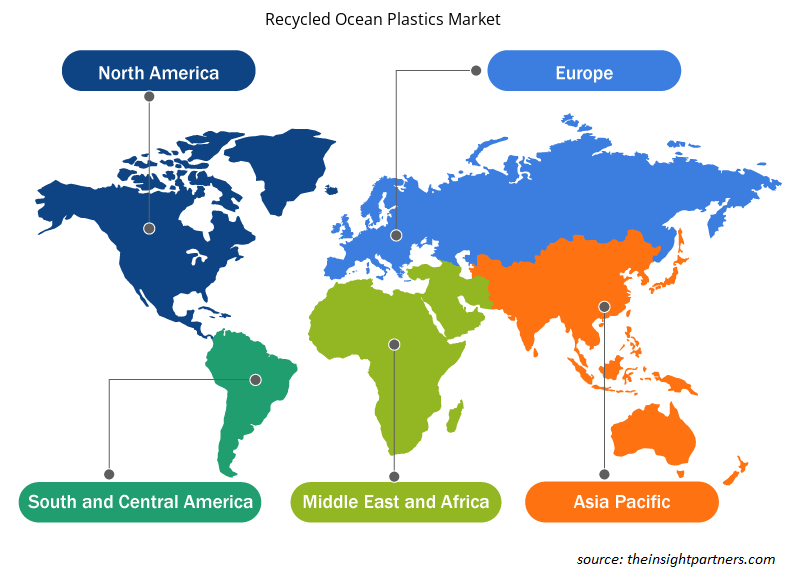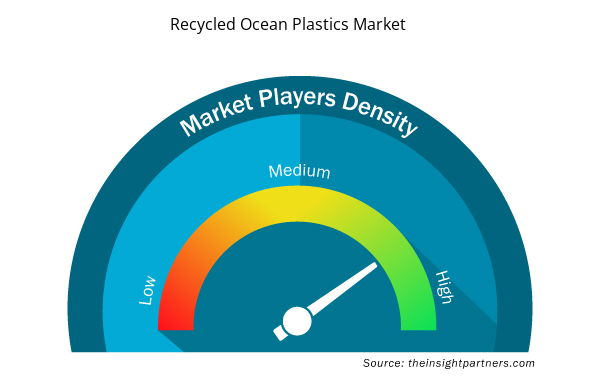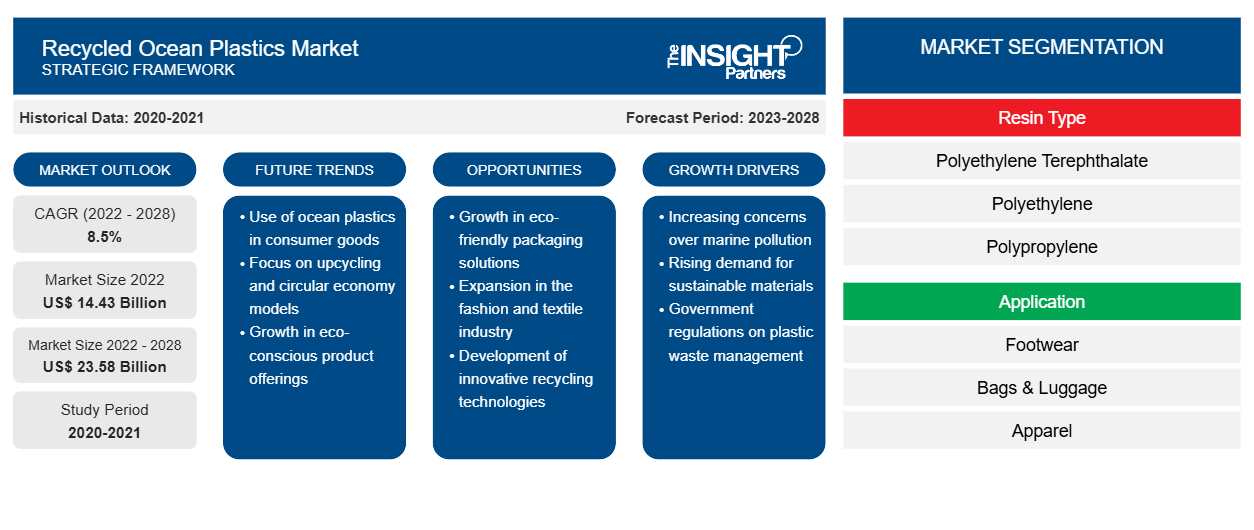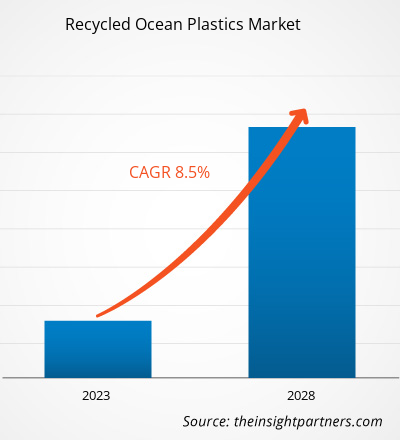リサイクル海洋プラスチック市場規模は2022年に144億3,291万米ドルと評価され、2022年から2028年にかけて8.5%のCAGRで成長すると予想されています。
プラスチック汚染は、生物に悪影響を与えるため、大きな懸念事項の 1 つです。毎年、何トンものプラスチック廃棄物が海や水路に投棄され、海洋生態系を妨げています。そのため、メーカーは海洋プラスチック廃棄物のリサイクルと、これらのプラスチックから靴、バッグ、荷物、財布、衣類などの便利な製品を製造することに重点的に取り組んでいます。
2021年、アジア太平洋地域は世界のリサイクル海洋プラスチック市場で最大の収益シェアを占めました。アジア太平洋地域の市場は、インド、中国、オーストラリア、日本、韓国、その他のアジア太平洋地域に分かれています。この地域のリサイクル海洋プラスチック市場の成長は、急速に拡大するファッション業界、人口の増加、地域全体での持続可能なソリューションに関する消費者の意識の高まりによって推進されています。中国とインドは、人口が最も急速に増加している国の一つです。人口の増加により、この地域では履物、包装、建設業界が急速に発展しています。環境に優しい製品を生産することで二酸化炭素排出量を削減しようとする地域のメーカーによる取り組みの増加も、この地域のリサイクル海洋プラスチック市場の成長を促進しています。
要件に合わせてレポートをカスタマイズする
このレポートの一部、国レベルの分析、Excelデータパックなど、あらゆるレポートを無料でカスタマイズできます。また、スタートアップや大学向けのお得なオファーや割引もご利用いただけます。
- このレポートの主要な市場動向を入手してください。この無料サンプルには、市場動向から見積もりや予測に至るまでのデータ分析が含まれます。
COVID-19パンデミックがリサイクル海洋プラスチック市場に与える影響
COVID-19パンデミック危機の発生前から、フットウェア、アパレル、包装、建設業界からの持続可能で環境に優しい材料に対する需要の高まりが、海洋プラスチックのリサイクルの需要を促進していました。しかし、2020年に各国政府がSARS-CoV-2感染拡大を抑制するためにロックダウンを実施し、プラスチックリサイクルユニットの稼働が停止し、海洋プラスチックのリサイクルが不足しました。GA Circularが発表したレポートによると、2020年の最初の数か月間にインド、ベトナム、フィリピンのリサイクルユニットの80%が閉鎖され、リサイクルプラスチックが大幅に不足しました。これは、海洋プラスチックのリサイクル市場の成長に悪影響を及ぼしました。
2021年、多くの経済が活動を再開しました。各国政府は以前に課された制限を緩和し、製造業者がフル稼働することを許可しました。この要因はプラスチックリサイクル活動にプラスの影響を与えました。多くの政府とNGOは、循環型経済をサポートし、海洋生態系へのプラスチック廃棄物の脅威を最小限に抑えるために、強力な廃棄物管理インフラストラクチャを構築しています。この要因は、予測期間中にリサイクルされた海洋プラスチックの需要を促進するでしょう。
市場分析
海洋プラスチックをリサイクルした製品の発売増加
プラスチック汚染は、生物に重大な脅威を与えるため、差し迫った世界的課題となっています。国連教育科学文化機関の海洋リテラシーポータルが提供する統計によると、プラスチック廃棄物は海洋汚染全体の約80%を占め、毎年約800万〜1,000万メートルトン(MMT)のプラスチックが海に流れ込んでいます。さらに、海洋のマイクロプラスチックの量は将来大幅に増加すると予想されています。とはいえ、多くの国で海洋のプラスチック汚染に関する意識が高まっており、政府や規制機関はこれらのプラスチックをリサイクルするための取り組みを行っています。多くの企業が、持続可能性の目標を達成し、全体的な環境フットプリントを削減するために、リサイクルされた海洋プラスチックを使用して、靴、ハンドバッグ、財布、サングラス、アパレルなどの革新的で魅力的な製品を発売しています。これらすべての要因が、リサイクルされた海洋プラスチック市場の成長を促進しています。
樹脂タイプの洞察
樹脂の種類に基づいて、世界のリサイクル海洋プラスチック市場は、ポリエチレンテレフタレート(PET)、ポリエチレン(PE)、ポリプロピレン(PP)、ポリスチレン(PS)などに分類されます。ポリエチレンテレフタレートセグメントは、2021年に市場で最大のシェアを占めました。ポリエチレンテレフタレート(PET)は重量が重く、形状を保持できるため、海洋や水路から簡単に抽出できるため、このセグメントの市場成長を後押ししています。さらに、バッグや荷物、履物用途のリサイクル海洋PETの需要の高まりも、この地域の市場成長を牽引しています。
アプリケーションインサイト
用途別に見ると、世界の海洋プラスチックリサイクル市場は、履物、バッグ・荷物、アパレル、建設資材、その他に分類されています。2021年にはアパレル部門が最大の市場シェアを占めました。ファッション業界からのアパレル需要の増加と世界人口の増加により、今後数年間で繊維業界で海洋プラスチックリサイクルの需要が高まると予想されます。
Aquafil SpA、BIONIC、Tide Ocean SA、Oceanworks、Textil Santanderina、Envision Plastics、OceanYarn、Waste2Wear、Unifi, Inc.、SABIC などは、海洋プラスチックのリサイクル市場で事業を展開している企業です。これらの企業は、新たな消費者の要求に応える革新的な製品を開発するために、R&D に多額の投資を行っています。市場プレーヤーは、顧客の需要を満たす高品質の製品を提供することに重点を置いています。
リサイクル海洋プラスチック市場の地域別分析
予測期間を通じてリサイクル海洋プラスチック市場に影響を与える地域的な傾向と要因は、Insight Partners のアナリストによって徹底的に説明されています。このセクションでは、北米、ヨーロッパ、アジア太平洋、中東、アフリカ、南米、中米にわたるリサイクル海洋プラスチック市場のセグメントと地理についても説明します。

- リサイクル海洋プラスチック市場の地域別データを入手
リサイクル海洋プラスチック市場レポートの範囲
| レポート属性 | 詳細 |
|---|---|
| 2022年の市場規模 | 144.3億米ドル |
| 2028年までの市場規模 | 235.8億米ドル |
| 世界のCAGR(2022年 - 2028年) | 8.5% |
| 履歴データ | 2020-2021 |
| 予測期間 | 2023-2028 |
| 対象セグメント | 樹脂の種類別
|
| 対象地域と国 | 北米
|
| 市場リーダーと主要企業プロフィール |
|
リサイクル海洋プラスチック市場のプレーヤー密度:ビジネスダイナミクスへの影響を理解する
リサイクル海洋プラスチック市場は、消費者の嗜好の変化、技術の進歩、製品の利点に対する認識の高まりなどの要因により、エンドユーザーの需要が高まり、急速に成長しています。需要が高まるにつれて、企業は提供を拡大し、消費者のニーズを満たすために革新し、新たなトレンドを活用し、市場の成長をさらに促進しています。
市場プレーヤー密度とは、特定の市場または業界内で活動している企業または会社の分布を指します。これは、特定の市場スペースに、その規模または総市場価値と比較して、どれだけの競合相手 (市場プレーヤー) が存在するかを示します。
リサイクル海洋プラスチック市場で事業を展開している主要企業は次のとおりです。
- アクアフィル SpA
- バイオニック
- タイドオーシャンSA
- オーシャンワークス
- テキスタイル サンタンデリーナ
免責事項:上記の企業は、特定の順序でランク付けされていません。

- リサイクル海洋プラスチック市場のトップキープレーヤーの概要を入手
レポートの注目点
- 海洋プラスチックリサイクル市場における進歩的な業界動向は、プレーヤーが効果的な長期戦略を策定するのに役立ちます。
- 先進国市場と発展途上国市場で採用されているビジネス成長戦略
- 2020年から2028年までの海洋プラスチックリサイクル市場の定量分析
- 海洋プラスチックリサイクルの世界需要の推定
- 業界で活動するバイヤーとサプライヤーの有効性を示すポーターの5つの力の分析
- 競争市場の状況を理解するための最近の動向
- 市場動向と見通し、およびリサイクル海洋プラスチック市場の成長を促進および抑制する要因
- 商業的利益を支える市場戦略を強調することで意思決定プロセスを支援し、リサイクル海洋プラスチック市場の成長につながる
- さまざまなノードにおける海洋プラスチックリサイクル市場の規模
- 市場の詳細な概要とセグメンテーション、およびリサイクル海洋プラスチック業界の動向
- 有望な成長機会があるさまざまな地域の海洋プラスチックリサイクル市場の規模
世界のリサイクル海洋プラスチック市場
世界のリサイクル海洋プラスチック市場は、樹脂の種類によって、ポリエチレンテレフタレート(PET)、ポリエチレン(PE)、ポリプロピレン(PP)、ポリスチレン(PS)、その他に分類されています。用途別には、履物、バッグ・荷物、アパレル、建設資材、その他に分類されています。
企業プロフィール
- アクアフィル SpA
- バイオニック
- タイドオーシャンSA
- オーシャンワークス
- テキスタイル サンタンデリーナ
- エンビジョンプラスチック
- オーシャンヤーン
- 廃棄物2着
- ユニファイ株式会社
- SABIC アモン
- 過去2年間の分析、基準年、CAGRによる予測(7年間)
- PEST分析とSWOT分析
- 市場規模価値/数量 - 世界、地域、国
- 業界と競争環境
- Excel データセット


- Helicopters Market
- Diaper Packaging Machine Market
- Mesotherapy Market
- Grant Management Software Market
- Environmental Consulting Service Market
- Smart Locks Market
- Real-Time Location Systems Market
- Authentication and Brand Protection Market
- Dropshipping Market
- Trade Promotion Management Software Market

Report Coverage
Revenue forecast, Company Analysis, Industry landscape, Growth factors, and Trends

Segment Covered
This text is related
to segments covered.

Regional Scope
North America, Europe, Asia Pacific, Middle East & Africa, South & Central America

Country Scope
This text is related
to country scope.
よくある質問
Asia Pacific is estimated to register the fastest CAGR in the global recycled ocean plastics market over the forecast period. Many APAC countries, such as China and India, are the world's fastest-growing populations. With a growing population, apparel, footwear, bags and luggage, construction material, and others are growing rapidly in APAC. The apparel industry is expanding in the APAC region because of growing population. The presence of established sectors, such as footwear and construction, in nations such as China, India, Japan, and South Korea has increased the demand for recycled ocean plastics in the region.
The apparel segment held the largest share of the market in 2022. The apparel sector has been experiencing robust growth due to lifestyle changes, growing urban population, and shift in consumer preferences. These factors drive the demand for recycled ocean plastic in the apparel industry. Furthermore, growing trend of recycled fashion, and the ability of plastic to be recycled is boosting the market growth in the apparel industry.
The footwear segment held the largest market share. Footwear is the most recycled post-consumer plastics. Use of recycled ocean plastic in shoe making can help reduce plastic waste and make footwear sustainable. Ethical footwear brands are taking initiatives against plastic waste by creating shoes made from recycled ocean plastic.
The polyethylene terephthalate segment held the largest market share. It is a polymer created by combining two monomers: modified ethylene glycol and purified terephthalic acid. Polyethylene terephthalate is the most widely used plastic; it is clear, strong, lightweight, and 100% recyclable. Polyethylene recycled plastics can be identified by recycling code#1; as they have a short lifespan, it is easy to recycle them.
The major players operating in the global recycled ocean plastics market are Aquafil S.p.A.; BIONIC; Tide Ocean SA; Oceanworks; Textil Santanderina; Envision Plastics; OceanYarn; Waste2Wear; Unifi, Inc.; and SABIC.
In 2022, Asia Pacific held the largest share of the global recycled ocean plastics market. The rise in the number of textile industries would cater the demand of recycled ocean plastics in the region. The region is also flourishing owing to presence of manufacturing facilities and cheap labor.
Trends and growth analysis reports related to Chemicals and Materials : READ MORE..
The List of Companies - Recycled Ocean Plastics Market
- Aquafil S.p.A.
- BIONIC
- Tide Ocean SA
- Oceanworks
- Textil Santanderina
- Envision Plastics
- OceanYarn
- Waste2Wear
- Unifi, Inc.
- SABIC
The Insight Partners performs research in 4 major stages: Data Collection & Secondary Research, Primary Research, Data Analysis and Data Triangulation & Final Review.
- Data Collection and Secondary Research:
As a market research and consulting firm operating from a decade, we have published and advised several client across the globe. First step for any study will start with an assessment of currently available data and insights from existing reports. Further, historical and current market information is collected from Investor Presentations, Annual Reports, SEC Filings, etc., and other information related to company’s performance and market positioning are gathered from Paid Databases (Factiva, Hoovers, and Reuters) and various other publications available in public domain.
Several associations trade associates, technical forums, institutes, societies and organization are accessed to gain technical as well as market related insights through their publications such as research papers, blogs and press releases related to the studies are referred to get cues about the market. Further, white papers, journals, magazines, and other news articles published in last 3 years are scrutinized and analyzed to understand the current market trends.
- Primary Research:
The primarily interview analysis comprise of data obtained from industry participants interview and answers to survey questions gathered by in-house primary team.
For primary research, interviews are conducted with industry experts/CEOs/Marketing Managers/VPs/Subject Matter Experts from both demand and supply side to get a 360-degree view of the market. The primary team conducts several interviews based on the complexity of the markets to understand the various market trends and dynamics which makes research more credible and precise.
A typical research interview fulfils the following functions:
- Provides first-hand information on the market size, market trends, growth trends, competitive landscape, and outlook
- Validates and strengthens in-house secondary research findings
- Develops the analysis team’s expertise and market understanding
Primary research involves email interactions and telephone interviews for each market, category, segment, and sub-segment across geographies. The participants who typically take part in such a process include, but are not limited to:
- Industry participants: VPs, business development managers, market intelligence managers and national sales managers
- Outside experts: Valuation experts, research analysts and key opinion leaders specializing in the electronics and semiconductor industry.
Below is the breakup of our primary respondents by company, designation, and region:

Once we receive the confirmation from primary research sources or primary respondents, we finalize the base year market estimation and forecast the data as per the macroeconomic and microeconomic factors assessed during data collection.
- Data Analysis:
Once data is validated through both secondary as well as primary respondents, we finalize the market estimations by hypothesis formulation and factor analysis at regional and country level.
- Macro-Economic Factor Analysis:
We analyse macroeconomic indicators such the gross domestic product (GDP), increase in the demand for goods and services across industries, technological advancement, regional economic growth, governmental policies, the influence of COVID-19, PEST analysis, and other aspects. This analysis aids in setting benchmarks for various nations/regions and approximating market splits. Additionally, the general trend of the aforementioned components aid in determining the market's development possibilities.
- Country Level Data:
Various factors that are especially aligned to the country are taken into account to determine the market size for a certain area and country, including the presence of vendors, such as headquarters and offices, the country's GDP, demand patterns, and industry growth. To comprehend the market dynamics for the nation, a number of growth variables, inhibitors, application areas, and current market trends are researched. The aforementioned elements aid in determining the country's overall market's growth potential.
- Company Profile:
The “Table of Contents” is formulated by listing and analyzing more than 25 - 30 companies operating in the market ecosystem across geographies. However, we profile only 10 companies as a standard practice in our syndicate reports. These 10 companies comprise leading, emerging, and regional players. Nonetheless, our analysis is not restricted to the 10 listed companies, we also analyze other companies present in the market to develop a holistic view and understand the prevailing trends. The “Company Profiles” section in the report covers key facts, business description, products & services, financial information, SWOT analysis, and key developments. The financial information presented is extracted from the annual reports and official documents of the publicly listed companies. Upon collecting the information for the sections of respective companies, we verify them via various primary sources and then compile the data in respective company profiles. The company level information helps us in deriving the base number as well as in forecasting the market size.
- Developing Base Number:
Aggregation of sales statistics (2020-2022) and macro-economic factor, and other secondary and primary research insights are utilized to arrive at base number and related market shares for 2022. The data gaps are identified in this step and relevant market data is analyzed, collected from paid primary interviews or databases. On finalizing the base year market size, forecasts are developed on the basis of macro-economic, industry and market growth factors and company level analysis.
- Data Triangulation and Final Review:
The market findings and base year market size calculations are validated from supply as well as demand side. Demand side validations are based on macro-economic factor analysis and benchmarks for respective regions and countries. In case of supply side validations, revenues of major companies are estimated (in case not available) based on industry benchmark, approximate number of employees, product portfolio, and primary interviews revenues are gathered. Further revenue from target product/service segment is assessed to avoid overshooting of market statistics. In case of heavy deviations between supply and demand side values, all thes steps are repeated to achieve synchronization.
We follow an iterative model, wherein we share our research findings with Subject Matter Experts (SME’s) and Key Opinion Leaders (KOLs) until consensus view of the market is not formulated – this model negates any drastic deviation in the opinions of experts. Only validated and universally acceptable research findings are quoted in our reports.
We have important check points that we use to validate our research findings – which we call – data triangulation, where we validate the information, we generate from secondary sources with primary interviews and then we re-validate with our internal data bases and Subject matter experts. This comprehensive model enables us to deliver high quality, reliable data in shortest possible time.


 このレポートの無料サンプルを入手する
このレポートの無料サンプルを入手する